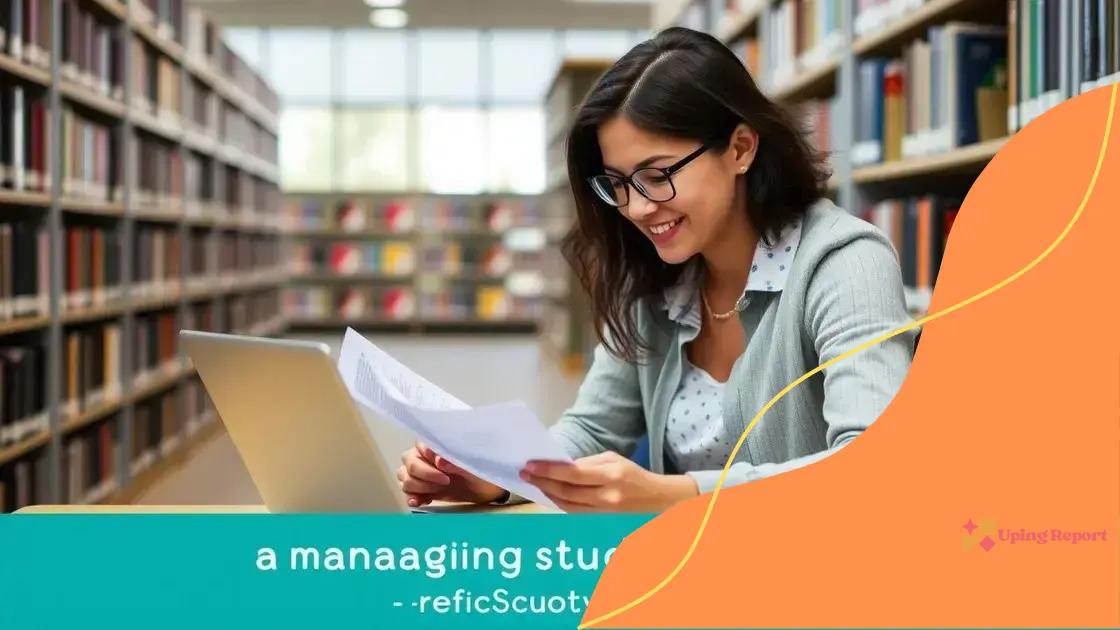Education policy shifts under Trump: What changed?

Education policy shifts under Trump significantly changed student loan regulations, public school funding, and the expansion of charter schools, raising concerns about equity and access to quality education in America.
Education policy shifts under Trump reshaped the landscape of learning in the U.S. These changes sparked conversations about funding, access, and the quality of education. Curious about how these shifts affect students today?
Overview of Trump’s education policy changes
During Trump’s presidency, education policy saw significant shifts that affected how schools are funded and how students learn. It’s important to understand these changes and their broader implications on the education system.
Key Changes in Education Policy
The Trump administration introduced various policies aiming to transform education. Some notable changes included a focus on school choice and an increase in funding for charter schools.
- Expansion of school voucher programs.
- Increased support for charter and private schools.
- Reduction in federal regulations for schools.
These changes aimed to provide parents with more options for their children’s education, believing it would lead to better outcomes. However, this shift raised debates on public school funding and equity.
Impact on Public Schools
The focus on alternatives like charter schools meant that public schools faced new challenges. Many educators feared that funding would be diverted away from traditional public schools, hurting resources available for students in those systems.
While some students benefited from the flexibility of new school types, concerns about potential inequalities arose. It prompted discussions about balancing funding and ensuring all students receive quality education.
In summary, understanding the overview of Trump’s education policy changes helps clarify the current landscape of education in America. These policies have set the stage for ongoing discussions about what reforms are necessary to provide equitable education for every child.
Impact on public school funding
The impact on public school funding has been profound during and after the changes made under Trump’s education policies. Funding dynamics shifted in response to the administration’s strong push for school choice.
Funding Reductions and Challenges
As more parents opted for charter and private schools, public schools began to experience reduced funding. This left many districts facing budgetary constraints.
- Reduction in federal support for traditional public schools.
- Increased competition for state education dollars.
- Potential job losses for educators due to tighter budgets.
These challenges forced schools to make difficult choices, often cutting essential programs such as arts and athletics. Ultimately, this raises concerns about the quality of education that students in public schools receive.
Long-term Effects
The long-term effects of these funding changes are still being felt today. Many low-income students, who rely heavily on public education, could be disproportionately affected. Budget cuts might limit their access to essential resources.
Disparities became evident as funding did not equally distribute among schools. Students in community areas with high charter school enrollment faced greater struggles for adequate resources. It’s vital to examine how these shifts continue influencing student outcomes.
By focusing on the effects of public school funding under the Trump administration, we highlight the ongoing debates surrounding equitable education in the United States.
Changes in student loan policies

The changes in student loan policies under Trump’s administration have had significant implications for borrowers. Understanding these changes is crucial for many seeking higher education or managing existing loans.
Key Changes to Student Loans
One of the most notable policies was the move away from certain income-driven repayment plans. This meant that many borrowers faced new challenges in managing their debts.
- Reduction in federal loan forgiveness programs.
- Increased emphasis on private loans over federal options.
- Changes to interest rates that impacted borrower costs.
These shifts raised concerns about accessibility to education for low-income students. Under these circumstances, some felt that pursuing higher education could lead to an overwhelming debt burden.
Impact on Borrowers
For existing borrowers, the changes created uncertainty around their repayment options. Many feared that they would struggle to repay their loans under new policies. Student debt has been a hot topic, with questions surrounding its impact on the economy and borrowers’ futures.
Additionally, students entering college faced different landscapes when considering how to finance their education. With the rising costs of tuition, many had to navigate complex loan options and evaluate their long-term financial commitments.
The evolution of student loan policies reflects ongoing debates over education accessibility and financial responsibility in the U.S. These discussions remain vital as federal and state governments seek to address these issues for current and future students.
Influence on charter schools and school choice
The influence on charter schools and school choice during Trump’s presidency marked a significant shift in educational priorities. These changes reshaped the landscape for students and parents across the country.
Expansion of Charter Schools
Under this administration, charter schools saw a push for growth, leading many states to expand these options. This expansion aimed to provide families with alternatives to traditional public education.
- Increased funding for charter school initiatives.
- Support for policies that promote school choice.
- Encouragement for the development of new charter schools.
Many advocates believed that charter schools could foster innovation and create more options for students. However, critics expressed concerns about the impact on public schools.
Impact on Public School Systems
As charter schools gained popularity, traditional public schools faced challenges with funding and enrollment. This shift left many schools struggling to maintain their quality of education.
Parents began exploring their choices more actively, often looking for schools that better matched their children’s needs. The school choice movement emphasized the idea that families should have the freedom to select schools based on various criteria, including academic performance and special programs.
This ongoing debate surrounding charter schools and school choice reflects deeper issues in the education system, such as equity and access to quality education. As schools adapt to these changes, the role of charter schools in fulfilling educational needs remains a crucial topic of discussion.
Long-term effects on education in America
The long-term effects on education in America from the policies implemented during Trump’s administration are significant and complex. These changes continue to influence how students learn and how schools operate across the nation.
Shifts in Educational Funding
One major effect has been the shift in educational funding. States have had to adjust their budgets as the demand for charter schools and school choice programs increased. This shift often led to decreased funding for traditional public schools.
- Increased competition among schools to attract students.
- Greater reliance on local funding sources rather than federal support.
- Changes in how educational performance is measured and valued.
Over time, these funding changes could create disparities in educational quality, particularly in low-income areas, challenging the promise of equitable education for all.
Impact on Student Outcomes
Additionally, student outcomes will likely be affected by how these policies encourage or discourage educational equity. Students from different backgrounds may find themselves with varied opportunities based on the types of schools available in their communities.
As systems evolve, the importance of adapting educational strategies to meet diverse needs becomes critical. This includes addressing issues such as accessibility to quality education and resources, which has become a growing concern.
Ultimately, the long-term effects on education in America from these changes require ongoing assessment and dialogue. Understanding these repercussions is vital for shaping future policies and ensuring that all students receive a fair chance at success.
In conclusion, the shifts in education policy under Trump have had a lasting impact on the American education system. Changes in funding, student loans, and the emphasis on charter schools have altered the landscape for students and educators alike. While these policies aimed to provide more options and opportunities, they have also raised concerns about equity and access for all students. Moving forward, it is essential to evaluate these changes and advocate for policies that ensure every child receives a fair and quality education.
FAQ – Questions about education policy shifts under Trump
What were the main changes in student loan policies during Trump’s presidency?
The main changes included reductions in federal loan forgiveness programs and a shift in focus toward private loans over federal options.
How did Trump’s policies affect public school funding?
Trump’s education policies often led to decreased funding for traditional public schools as more resources were allocated to charter schools and school choice programs.
What is the impact of charter schools on the education system?
Charter schools expanded significantly under Trump’s administration, leading to increased competition but raising concerns about the potential impact on traditional public schools.
How do these changes affect educational equity?
The emphasis on school choice and charter schools can create disparities, particularly for low-income students who may have less access to quality education options.
